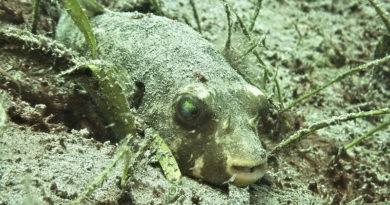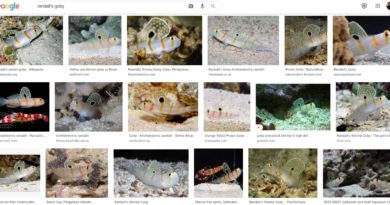Fish Behavior in Ten Short Videos
There are over 20000 species of fishes in Planet Earth’s oceans, rivers and lakes. Many of them show sophisticated, complex behaviors. During the last few years I have been lucky enough to capture some of these behaviors. I put together this collection of videos which together illustrate a number of interesting fish behaviors: fighting, territoriality, locomotion, schooling, hunting and symbiosis. Of course these videos only scratch the surface – there is so much more interesting fish behavior to observe and film. But the videos will give a nice intro to what fish do – and I hope they are entertaining to watch as well. On a side note, I am on a crusade against boring elevator-music used in underwater videos.
Fighting and Territoriality
Gobies are a large family (over 2000 species) of small fishes (some of the smallest vertebrates are gobies). Even though they are small, they can be feisty. Gobies of the genus Valencienna live in pairs, and share a burrow which they dig in the sand. The sandy area around this burrow the fish consider their territory. Intruders of the same species are quickly attacked by ramming them. Here the two fish who cooperate to fight of an intruder into their home territory. The action is so fast that I had to show it again in slow motion.
Dragonets are a family of fishes related to the gobies. The beautiful mandarinfish is probably the most famous dragonet. These two here are proud dragonets (Calonymus superbus). They fight not over territory, but for mating rights. At the end of the video, the winner of the fight between the two male fish approaches a female.
This is a really unusual fight – we are dealing with another territorial fish, a damselfish. Damselfishes are another big family of fish; the anemonefishes (not called Nemo) belong to the damselfish. The damselfish shown in this video defends not an anemone, but a piece of algae-covered rock; it feeds on the algae. It basically defends its farm. However, in this case the intruders were a school of marine catfish, which just dashed apart when the farmer damsel stormed into their school. It was punching water!
And, fish don’t always fight other fish; sometimes they also fight divers. I unknowingly entered the vicinity of this titan triggerfish’s nest, and that got it very angry. It chased me relentlessly; these are big fish, with powerful teeth, so I tried my best to get away from it. Only after a few charges did it give up.
Locomotion
Fishes swim, one would think. Generally, that’s true. But, different species swim in different ways. Some undulate their complete bodies, others flap their pectoral fins only. In this medley of fish sightings from Dauin on Negros Island in the Philippines a puffer fish seems to roll down an underwater sandy slope.
Some fish don’t even like to swim! This is the case with this spiny devilfish, a species of stonefish. It prefers to crawl on its pectoral fin spines. It’s also really interesting to see it spread its pectoral fins, showing the red warning colors on them; this fish is highly venomous and can even kill people (the venom is in its hollow dorsal fin spines).
Parts of this video are shot with the intriguing Inon “bug eye” wide-angle close-focus lens.
Schooling
An important kind of behavior for many fish species is schooling. Fish of many species are basically never found alone, always in schools. I especially like to watch marine catfish schooling:
And here are more species of schooling fish:
Hunting
Fish hunt in many ways, they chase their prey, they lie in wait, or they use some pretty sophisticated tricks: This video shows a neat trick by a cornetfish. It wants to hunt, and it normally does this by sneaking up on its prey. In the featureless underwater sandy planes of Dauin, there are no corals to hide behind … hence it sneaks up behind a pufferfish.
Symbiosis
This is my favorite chapter in fish behavior – the symbiosis of gobies and shrimps. The shrimp digs and maintains an underground burrow in the sand, but has poor eyesight. The goby hence acts as a watchman, warning the shrimp of approaching predators with its body language. This symbiosis is not easy to observe, since the goby is very shy.
Happy fishwatching! – Klaus


